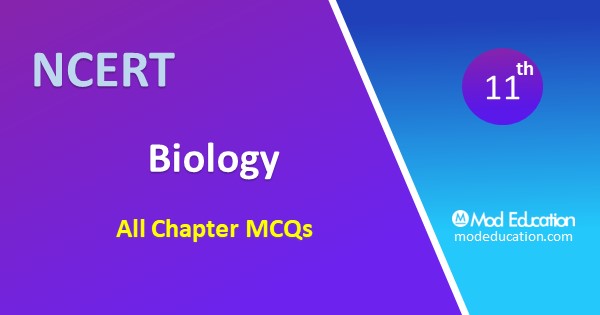MCQs questions for class 11 biology chapter 13 : MCQs Questions for Class 11 Biology Chapter 13 NEET MCQ Photosynthesis in Higher Plants with Answers PDF Free Download prepared here according to the latest CBSE RBSE ans other State Board syllabus and NCERT curriculum. Students can practice CBSE Class 11 Biology MCQs Multiple Choice Questions for all Chapter. Biology NEET MCQ Photosynthesis in Higher Plants

MCQs questions for class 11 biology chapter 13
Q1. The process of taking in CO2 by plants and releasing O2 is termed as
(a) Transpiration
(b) Respiration
(c) Photosynthesis
(d) Endosmosis
(c) Photosynthesis
Q2. How many turns of Calvin cycle yield one molecule of glucose?
(a) Eight
(b) Two
(c) Six
(d) Four
(c) Six
Q3. The function of ATP in photosynthesis is the transfer of energy from the Biology NEET MCQ Photosynthesis in Higher Plants
(a) Dark reaction to the light reaction
(b) Light reaction to the dark reaction
(c) Chloroplasts to mitochondria
(d) Mitochondria to chloroplasts
(b) Light reaction to the dark reaction
Q4. Which enzyme is most abundantly found on earth?
(a) Catalase
(b) Rubisco
(c) Nitrogenase
(d) Invertase
(b) Rubisco
Q5. Photosynthesis is an oxidation reduction process, the materials that is oxidised is
(a) CO2
(b) NADP
(c) H2O
(d) PGA
(c) H2O
Q6. Which one of the following is represented by Calvin cycle?
(a) Reductive carboxylation
(b) Oxidative carboxylation
(c) Photophosphorylation
(d) Oxidative phosphorylation
(a) Reductive carboxylation
Q7. Respiration and photosynthesis both require
(a) Green cells
(b) Sunlights
(c) Cytochromes
(d) Organic fuel
(c) Cytochromes
Q8. Photosynthetically active radiation (PAR) represents which of the following range of wavelength?
(a) 340-450 nm
(b) 400-700 nm
(c) 450-950 nm
(d) 500-600 nm
(b) 400-700 nm
Q9. In plants during the process of photosynthesis
(a) CO2 is taken in
(b) O2 is taken in
(c) CO2 is taken out
(d) O2 is taken in and CO2 is given out
(a) CO2 is taken in
Q10. Which range of wavelength (in nm) is called photosynthetically active radiation (PAR)?
(a) 400-700
(b) 760-10,000
(c) 100-390
(d) 390-430
(a) 400-700
Q11. Which one of the following statements about cytochrome P-450 is wrong?
(a) It is a colored cell
(b) It is an enzyme involved in oxidation reaction
(c) It has an important role in metabolism
(d) It contains iron
(a) It is a colored cell
Q12. Discovery of Emerson effect has already shown the existence of :–
(a) Two distinct photosystems
(b) Light and dark reactions of photosynthesis
(c) Photophosphorylation
(d) Photorespiration
(a) Two distinct photosystems
Q13. The concentration of CO2 in the atmosphere is approximately
(a) 0.003%
(b) 0.03%
(c) 0.30 %
(d) 3.00 %
(b) 0.03%
Q14. What is common between chloroplasts, chromoplasts and leucoplasts?
(a) Storage of starch, proteins and lipids
(b) Possession of thylakoids and grana
(c) Presence of pigments
(d) Ability to multiply by a fission-like process
(d) Ability to multiply by a fission-like process
Q15. During ATP synthesis electron pass through
(a) Water
(b) Cytochromes
(c) O2
(d) CO2
(b) Cytochromes
Q16. Kranz anatomy is a feature of
(a) C3 plants
(b) CAM plants
(c) C4 plants
(d) All of these
(b) CAM plants
Q17. Which of the following is a 4-carbon compound? Biology NEET MCQ Photosynthesis in Higher Plants
(a) Oxaloacetic acid
(b) Phosphoglyceric acid
(c) Ribulose biphosphate
(d) Phosphoenolpyruvate
(a) Oxaloacetic acid
Q18. Which of the following process (C4 cycle) occurs in bundle sheath cells?
(a) Regeneration
(b) Fixation
(c) Carboxylation
(d) Decarboxylation
(d) Decarboxylation
Q19. Light reactions of photosynthesis occurs in
(a) stroma
(b) thylakoid
(c) grana
(d) cytoplasm of cell
(c) grana
Q20. Water stress causes
(a) opening of stomata
(b) increase in metabolic rate
(c) wilting of leaves
(d) lesser availability of carbon dioxide
(c) wilting of leaves
Q21. Photosynthesis is most active in Biology NEET MCQ Photosynthesis in Higher Plants
(a) Sun light
(b) Yellow light
(c) Red light
(d) Green light
(c) Red light
Q22. The specific characteristic of C4-plants is:
(a) bulliform cells
(b) isobilateral leaf
(c) kranz anatomy
(d) parallel veins configuration
(c) kranz anatomy
MCQ Questions for Class 11 Biology with Answers Chapter Wise PDF Download
MCQ Questions of Class 11 Biology with Answers Pdf will guide students to do a quick revision for all chapter.
- MCQs questions for class 11 biology chapter 1 The Living World
- MCQs questions for class 11 biology chapter 2 Biological Classification
- MCQs questions for class 11 biology chapter 3 Plant Kingdom
- MCQs questions for class 11 biology chapter 4 Animal Kingdom
- MCQs questions for class 11 biology chapter 5 Morphology of Flowering Plants
- MCQs questions for class 11 biology chapter 6 Anatomy of Flowering Plants
- MCQs questions for class 11 biology chapter 7 Structural Organisation in Animals
- MCQs questions for class 11 biology chapter 8 Cell: The Unit of Life
- MCQs questions for class 11 biology chapter 9 Biomolecules
- MCQ questions for class 11 biology chapter 10 Cell Cycle and Cell Division
- MCQ questions for class 11 biology chapter 11 Transport in Plants
- MCQ questions for class 11 biology chapter 12 Mineral Nutrition
- MCQ questions for class 11 biology chapter 13 Photosynthesis in Higher Plants
- MCQ questions for class 11 biology chapter 14 Respiration in Plants
- MCQ questions for class 11 biology chapter 15 Plant Growth and Development
- MCQ questions for class 11 biology chapter 16 Digestion and Absorption
- MCQ questions for class 11 biology chapter 17 Breathing and Exchange of Gases
- MCQ questions for class 11 biology chapter 18 Body Fluids and Circulation
- MCQ questions for class 11 biology chapter 19 Excretory Products and their Elimination
- MCQs questions for class 11 biology chapter 20 Locomotion and Movement
- MCQs questions for class 11 biology chapter 21 Neural Control and Coordination
- MCQ questions for class 11 biology chapter 22 Chemical Coordination and Integration
NCERT MCQ Questions for Class 11 Chemistry with Answers
PDF Free Download for Telegram
